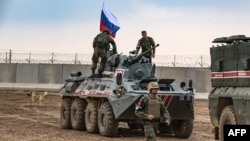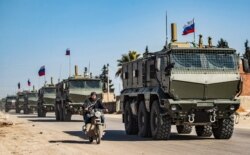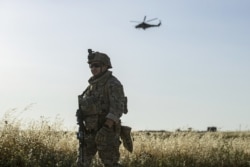Russian forces increasingly face rejection by the local population in northeast Syria as they attempt to expand their military presence in that part of the war-torn country, local sources and experts said.
Last week, a Russian military convoy arrived in a village near Syria’s border with Turkey where Russian officers reportedly expressed their desire to set up a military outpost in the area.
“About 12 Russian armored vehicles arrived in our village last Friday,” said Osman Khalil, a local leader at the Sarmsakh village in northeast Syria. “Over 200 residents of our village and a nearby one quickly gathered and headed to where the Russians were.”
Speaking with VOA in a phone interview, Khalil said, “A Russian commander told us they wanted to build an outpost in the village for our protection. We simply told them that we didn’t want their protection and that we didn’t trust the Russians.”
He added, “We told them if they didn’t leave, we would throw stones at their vehicles. They said if we didn’t want them, they would leave. And that’s how they left the village.”
Rami Abdulrahman, director of the Syrian Observatory for Human Rights, told VOA that his researchers on the ground confirmed last week’s incident.
This is not the first time Russian forces have faced protests by local Kurds in northeast Syria. In June, a Russian convoy drew local opposition when it arrived at a village near Syria’s borders with Turkey and Iraq with the aim of building a base.
In recent months, Russia, a main backer of Syrian President Bashar al-Assad’s regime, has increased its foothold in the country’s northeast, which is largely controlled by the Kurdish-led Syrian Democratic Forces (SDF).
After the Turkish military and its allied Syrian militias launched an offensive against the U.S.-backed SDF in October 2019, Russian troops stepped into the region, following a partial U.S. troop withdrawal from the border area between Syria and Turkey.
On Tuesday, the Syrian Observatory reported the arrival of additional weaponry and logistics equipment at the Qamishli airport destined for Russian forces in northeast Syria.
VOA could not reach the SDF for comment, but a Kurdish commander said in a previous interview with VOA that “the Russians have been roaming almost freely in our region” since October 2019.
‘Trust deficit’
“Russia suffers from a trust deficit in most areas of northeast Syria,” Nicholas Heras, a Middle East expert at the Institute for the Study of War in Washington, told VOA. “The Russians have tried to present themselves as the honest brokers between the Kurds and Damascus, to little tangible effect.”
Heras noted that “an expanded Russian military presence in Qamishli, where the Russians are seeking to establish a major base, would undermine the leverage the Syrian Kurds have on Assad, which cannot bring them back under his rule through sheer military force.”
“The Syrian Kurds are trying to tell Russia that on their home turf, they and not Moscow or Damascus call the shots,” he added.
Challenging the US
Other experts say Russia’s attempts to expand militarily in northeast Syria are meant to undermine the U.S. military presence in the region.
“The Russians are trying to challenge the U.S. and trying to use locals, so there is a conflict for hearts and minds,” said Seth Frantzman, director of the Middle East Center for Reporting and Analysis.
“If reports are true that the locals oppose the bases, that is a tremendous reversal from last October and shows the U.S. has been able to restore confidence,” Frantzman told VOA. “The question is when the U.S. might reverse its policy again.”
The U.S. currently has about 500 troops in the area who, according to U.S. officials, are protecting the region’s oil fields and preventing Islamic State from reemerging.
Last month, U.S. officials said an American company reached a deal with Kurdish-led authorities in northeast Syria to develop and export crude oil in areas under their control.
The deal has angered the Russian and Syrian governments, both describing it as illegal.
Tensions between Russian and U.S. forces continue in Syria. In late August, U.S. military officials said that four U.S. troops were injured in an altercation with Russian forces in northeast Syria.












